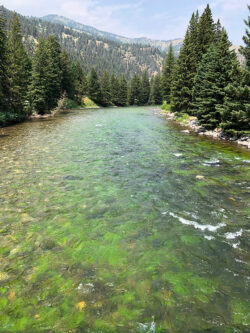The Gallatin River’s west fork has turned green along the western half of the river. The green is the result of nutrient rich wastewater from Big Sky. It takes a lot of green to live in Big Sky!
The new green algae deal can be seen along 22 miles downstream from Big Sky. Taylor Forks is also green. The non-toxic blooms are from a filamentous alga called “Cladophora”.
If the bloom becomes denser and more regular, it will kill the mayflies, stoneflies, and caddis insects. Other aquatic critters like scuds could become more abundant. Juvenile fish are also at risk due to the impact of wastewater.
The Montana Dept. of Environmental Quality is coordinating with the Gallatin River Task Force to monitor the blooms. These algae issues started in 2005 and continue to grow each year since. The blooms usually start in August when the river is at it’s lowest and warmest. Hard water, elevated levels of nitrates and phosphorus, warmer water, sunny weather all drive alga growth.
Fertilizer used on lawns and golf courses load these nutrients into the watershed. Big Sky uses treated wastewater to water lawns and golf courses. Wastewater is also coming from old septic systems. Other leaks in holding ponds and excessive flows during storms, also adds excessive nutrients into the river.
Big Sky needs a centralized wastewater treatment system. The town recently approved funding to upgrade and secure their systems. Responsible growth and planning are needed to keep the Gallatin River healthy.
More people mean more sewage, waste, and stress onto the environment. Living downstream means that thousands of other Montanans are affected by this excessive Big Sky waste. Many Montana fisheries are currently being overfished and abused.
The Algae is a sign of things to come. It needs to be fixed now or the wonderful Gallatin River will become another used to great Big Sky Country destination.
Montana Grant
For more Montana Grant, find him going with the flow at www.montanagrantfishing.com.